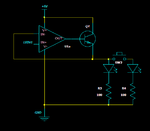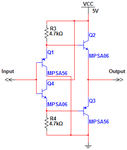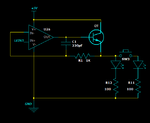jackmorrison
Newbie level 6

I want to increase the current drive of a high-impedance voltage source (function generator or DAC), "LEDV1" input in the schematic, to accurately drive a variable number of parallel LEDs (for illustration, I've shown a pushbutton to optionally connect a second LED). Since the load can change rapidly, I can't use constant-current control. I've set up an NPN BJT voltage follower (common-collector or emitter follower), left side of the schematic below, which works to first order. The PNP input stage is to cancel most of the DC offset - I could remove that for the discussion (remove R1 and Q1, and feed LEDV1 directly into base of Q3), but I've left it in in case it's relevant.

The problem is that the output voltage (at Q3 emitter) varies somewhat depending on the number of LEDs connected. For example, for the same input, I get 2.09V with one LED and 1.85V with 32 LEDs. I've tried adding a second NPN (Darlington pair, right circuit with Q4/Q5), and optionally a feedback resistor R7, with little improvement.
Is there a trick to get the output more consistent regardless of load current? I can live with a DC offset, and with a gain that's not exactly 1.0, but I don't want the output to vary depending on the number of LEDs.
Thanks for any suggestions.

The problem is that the output voltage (at Q3 emitter) varies somewhat depending on the number of LEDs connected. For example, for the same input, I get 2.09V with one LED and 1.85V with 32 LEDs. I've tried adding a second NPN (Darlington pair, right circuit with Q4/Q5), and optionally a feedback resistor R7, with little improvement.
Is there a trick to get the output more consistent regardless of load current? I can live with a DC offset, and with a gain that's not exactly 1.0, but I don't want the output to vary depending on the number of LEDs.
Thanks for any suggestions.







